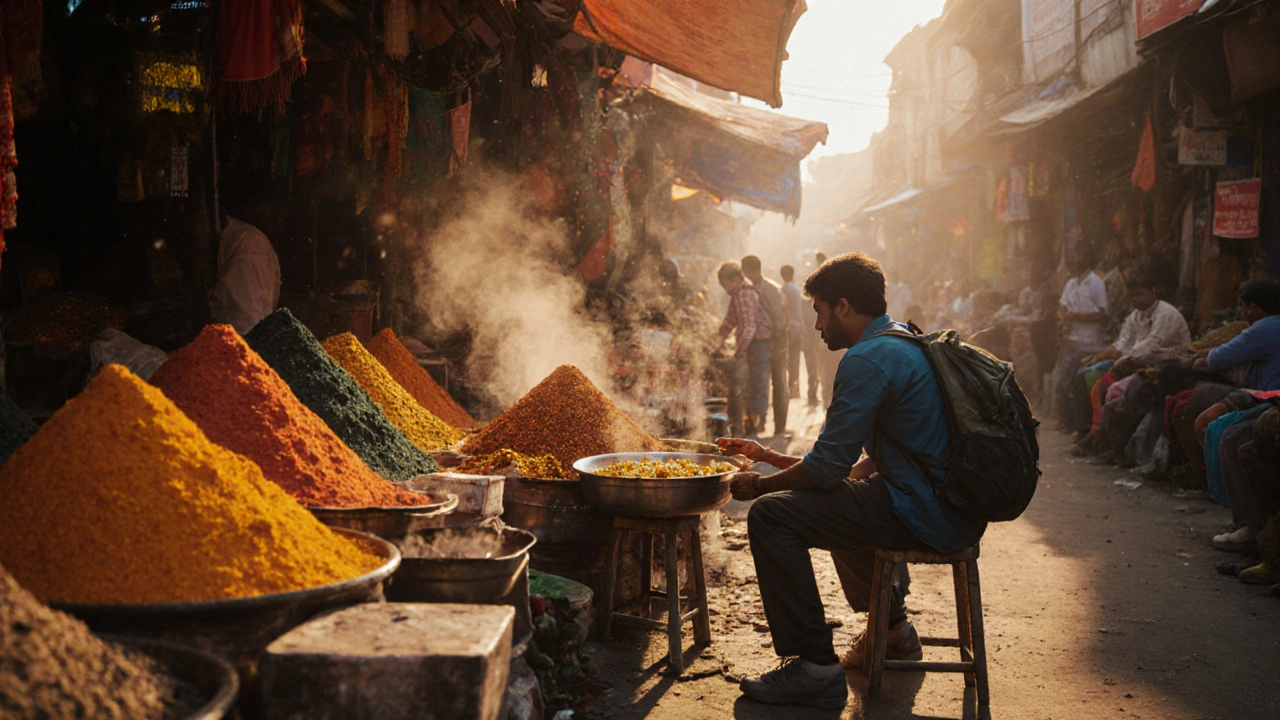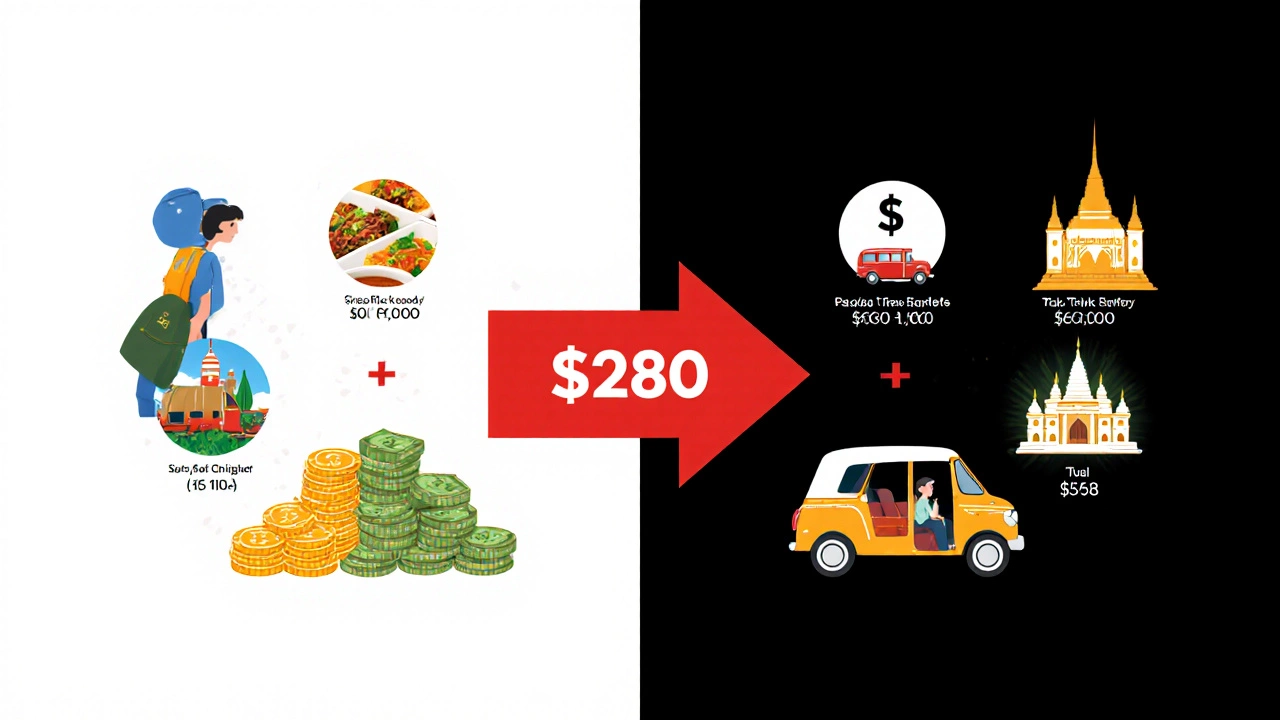Which is cheaper, India or Thailand? Budget travel showdown 2025
 Nov, 18 2025
Nov, 18 2025
Budget Travel Calculator: India vs Thailand
Calculate Your Travel Budget
Estimated Travel Budget
India saves you $ 0 0% compared to Thailand.
Breakdown
| Category | India | Thailand |
|---|---|---|
| Accommodation | ||
| Food | ||
| Transportation | ||
| Attractions | ||
| Drinks & Snacks | ||
| Other Fees | ||
| Total | $ | $ |
If you're planning a trip across Asia and trying to stretch your dollars as far as they'll go, you're probably wondering: India or Thailand? Both promise vibrant cultures, delicious food, and stunning landscapes-but which one actually costs less? The answer isn't simple, but it’s clearer than you think.
Accommodation: Where you sleep makes a big difference
In India, you can find a clean, basic guesthouse in a tourist hotspot like Goa or Jaipur for as little as $8-$12 a night. In smaller towns or rural areas, it drops to $5. Hostels in Delhi or Mumbai run $6-$10. Even mid-range hotels with AC and hot water often cost under $30.
Thailand is similar-but slightly pricier. A basic guesthouse in Chiang Mai or Pai runs $10-$15. In beach towns like Koh Lanta or Krabi, even budget bungalows start at $12-$18. In Bangkok, you can find $8 hostels, but they’re often noisy and far from the action. For a private room with a fan and clean bathroom, expect to pay $15-$25 across the country.
Bottom line: India wins on pure budget lodging. Thailand’s prices creep up fast near beaches and tourist zones.
Food: Eat like a local for pennies
Indian street food is legendary for its price and flavor. A plate of dal chawal (lentils and rice) costs $0.50. A plate of pav bhaji? $0.70. A masala dosa? $0.80. Even a full meal at a small restaurant with curry, roti, and tea will set you back under $2. In tourist areas, prices double-but still stay under $5.
Thailand’s street food is just as good, but slightly more expensive. A plate of pad thai? $1.50-$2. A bowl of tom yum goong? $2. A mango sticky rice dessert? $1.50. A full meal with rice, protein, and soup? $3-$4. In tourist-heavy areas like Phuket or Bangkok’s Khao San Road, you’ll pay $5-$7 for the same dishes.
India wins again. You can eat three meals a day in India for under $5. In Thailand, you’ll need $6-$8 to do the same.
Transportation: Getting around on a dime
In India, local buses cost $0.10-$0.30 per ride. Auto-rickshaws? $1-$2 for short trips. Long-distance trains are incredibly cheap. A 12-hour sleeper class ticket from Delhi to Jaipur? $8-$12. Overnight buses between cities? $10-$15.
Thailand’s public transport is efficient but pricier. A tuk-tuk ride in Chiang Mai? $2-$4. A local bus? $0.50-$1. A train from Bangkok to Ayutthaya? $5-$7. A flight from Bangkok to Chiang Mai? $40-$60 if booked in advance. Domestic flights are common because distances are large and roads are slow.
India wins on ground transport. You can travel across the country for under $50 in trains and buses. In Thailand, you’ll likely spend $70-$100 to cover the same distance, especially if you factor in flights.
Attractions and activities: Seeing the sights
Most temples and heritage sites in India cost $1-$3 to enter. The Taj Mahal? $15 for foreigners. A wildlife safari in Ranthambore? $30-$40. Yoga classes in Rishikesh? $5-$10. Even guided tours of historical forts rarely exceed $15.
Thailand’s entry fees are higher. Wat Phra Kaew in Bangkok? $15. A day trip to Angkor Wat? Wait-that’s Cambodia. But in Thailand, a full-day island-hopping tour in Phuket? $30-$50. A temple visit? $5-$10. A Thai cooking class? $25-$40. Even a simple massage? $8-$12.
India is cheaper for cultural sites. Thailand charges more for experiences, especially those aimed at tourists. You pay for the polish.

Drinks and snacks: The little things add up
A bottle of water in India? $0.20. A local beer? $0.80. A cup of chai? $0.15. A coconut? $0.50.
In Thailand, bottled water is $0.30-$0.50. A Chang beer? $1.50. A fresh coconut? $1. A smoothie? $2. Even a bag of chips from a convenience store costs more.
India wins by a mile here. Alcohol and snacks are cheaper, and you won’t feel guilty buying a drink every afternoon.
Hidden costs: What nobody tells you
In India, you might pay for parking, toilet paper, or a small tip at temples. But most of these are under $0.50. Wi-Fi is often free in cafes and guesthouses. ATMs are everywhere, and fees are low.
Thailand has more hidden fees. Many guesthouses charge a $1-$2 daily resort fee. Beach clubs charge $5-$10 just to sit on the sand. Some temples require you to buy a $2 donation ticket even if you’re not entering. Taxis in tourist areas sometimes inflate prices if you don’t haggle.
India’s system is simpler. You pay for what you get. Thailand’s system is designed to extract a little extra from tourists.
Real budget breakdown: A week in each country
Here’s what a solo traveler actually spends in a week, eating local, staying in budget spots, and using public transport:
| Category | India | Thailand |
|---|---|---|
| Accommodation | $50 | $85 |
| Food | $30 | $50 |
| Transport | $25 | $60 |
| Attractions | $20 | $40 |
| Drinks & Snacks | $15 | $25 |
| Other (tips, fees) | $10 | $20 |
| Total | $150 | $280 |
That’s a $130 difference for the same week. India lets you live like a local without sacrificing comfort. Thailand gives you more convenience and polish-but at a steep price.

When Thailand might be worth the extra cost
India is cheaper-but Thailand is easier. If you hate haggling, hate spicy food, or want reliable English signage, Thailand wins. The infrastructure is better. Tourist areas are cleaner. Public restrooms actually have toilet paper. If you’re a first-time traveler to Asia, Thailand feels less overwhelming.
Also, if you’re flying from Australia or New Zealand, flights to Thailand are often cheaper and more frequent than to India. That can offset some of the daily costs.
When India is the clear winner
If you want to travel slow, eat street food daily, take overnight trains, and explore ancient temples without spending a fortune-India is unbeatable. You can stretch $200 for three weeks. You can live on $5 a day and still feel rich.
India also offers more variety: deserts, mountains, backwaters, Himalayan villages, and bustling cities-all within one country. You don’t need to fly to see it all.
Final verdict: Which is cheaper?
India is significantly cheaper. On average, you’ll spend less than half what you’d spend in Thailand for the same experience. You get more food, more transport, more sights, and more culture for every dollar.
Thailand is nicer, cleaner, and more tourist-friendly. But if your goal is to travel on a tight budget and see as much as possible? India wins without a fight.
Is India really cheaper than Thailand for backpackers?
Yes, by a wide margin. Backpackers in India typically spend $150-$200 per week. In Thailand, the same lifestyle costs $250-$350. Food, lodging, and transport are all significantly cheaper in India, especially outside major tourist zones.
Can I travel Thailand on a $100 budget per week?
It’s extremely difficult. Even in the cheapest areas like Isaan or rural northern Thailand, you’ll struggle to keep food, lodging, and transport under $100. You’d need to sleep in dorms, eat only street food, avoid all tours, and skip flights. In India, $100 a week is easy-and you’ll still have room for souvenirs and extra meals.
Are flights to India cheaper than to Thailand?
It depends on where you’re flying from. From the U.S. or Europe, flights to Thailand are often cheaper and more direct. From Australia or New Zealand, flights to both countries are similarly priced. But once you land, daily costs in India are 40-50% lower, so the flight difference usually balances out over a 2-3 week trip.
Is Thailand safer than India for solo travelers?
Both countries are generally safe for solo travelers. Thailand has more tourist-focused policing and clearer signage in English. India has more crowded spaces and occasional scams, but violent crime against tourists is rare in both. The bigger risk in India is overcharging or being misled-something you can avoid by learning basic haggling and checking prices in advance.
Which country has better food for budget travelers?
India. The variety is endless-curries, dosas, parathas, chaat, street noodles, and vegetarian options everywhere. Thailand’s food is delicious too, but portions are smaller, and meat-heavy dishes cost more. In India, you can eat three full meals for under $3. In Thailand, you’ll need $5-$7 to match that.
What to do next
If you’re still deciding, ask yourself: Do you want to save money or avoid hassle? India is the budget king. Thailand is the comfort king. If you’re on a tight budget and don’t mind a little chaos, go to India. If you want a smoother, more predictable experience and can spend a bit more, Thailand delivers.
Either way, you’ll leave with full stomachs, unforgettable memories, and a better sense of what travel really costs in Asia.